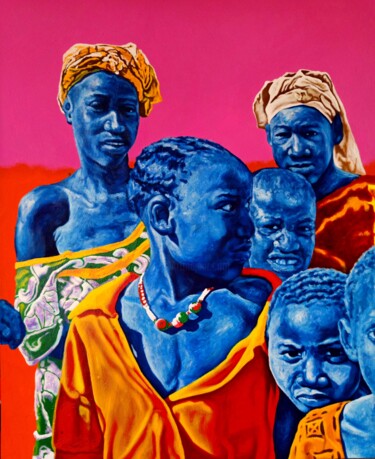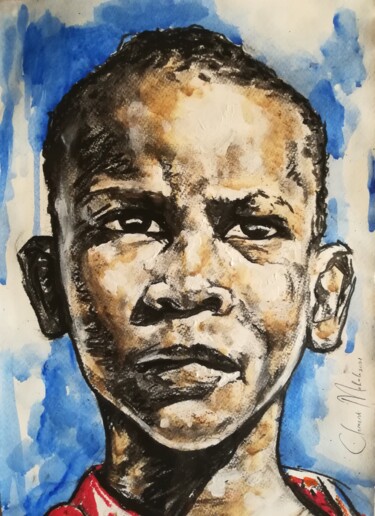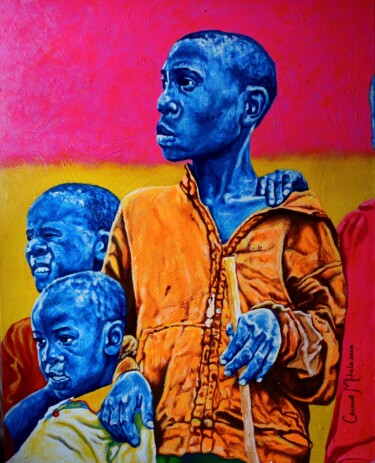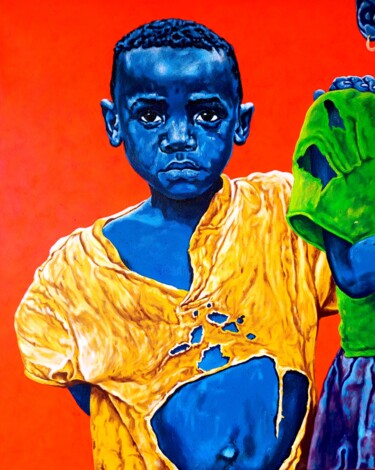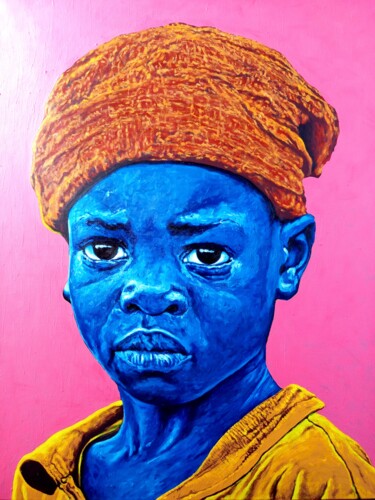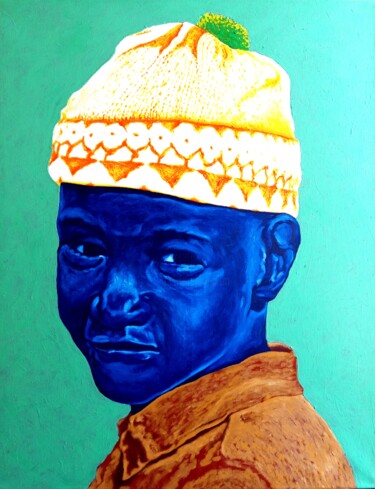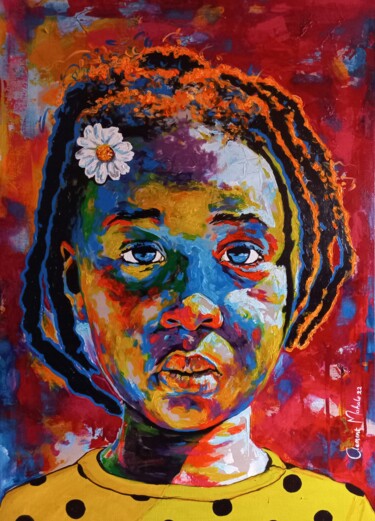Clement Mohale
남아프리카 출신의 현대 예술가 클레멘트 모헤일(Clement Mohale)은 대담하고 생동감 넘치며 깊은 감동을 주는 작품을 선보입니다. 그의 예술적 표현은 목탄, 파스텔, 아크릴, 유성 물감 등 다양한 매체를 활용하여 끝이 없습니다. 그는 기본 컬러의 풍부한 팔레트를 통해 자신의 생각과 감정을 능숙하게 전달하며, 매체나 컨셉의 한계에 얽매이지 않습니다.
인간의 조건을 형성하는 일상의 경험에서 영감을 받은 클레멘트는 이 다면적인 존재 전체를 캡슐화하려고 합니다. 그의 작품은 다양한 주제를 다루지만 어린이들은 희망의 강력한 상징으로 중심 무대에 오르는 경우가 많습니다. 그의 가족 일족 역사의 요소가 결합된 왕관은 자신의 권리를 인정하고 더 큰 이익을 위해 결정을 내릴 수 있는 권한을 상징하는 강력한 은유로 나타납니다.
클레멘트는 요하네스버그 스카이라인을 가족의 과거와 은유적인 왕국으로 병치하면서 희망적인 현재를 받아들이면서 뿌리를 다시 찾는 이야기를 엮습니다. 그는 빈곤, 노숙자, 부적절한 위생, 교육에 대한 제한된 접근성과 같은 중요한 문제를 다루면서 사회 정치적, 경제적 문제에 초점을 맞추고 있습니다. Clement는 자신의 예술 작품을 통해 이러한 문제가 일반 개인의 복지에 어떤 큰 영향을 미치는지 조명하고 시청자가 보다 공평한 세상을 만드는 데 있어 자신의 역할을 성찰하도록 유도하기 위해 노력합니다.
Clement Mohale의 작품은 미국, 스위스, 독일, 영국 등을 포괄하는 컬렉션을 통해 국제적인 규모로 인지도와 평가를 얻었습니다. 미학을 넘어, 그의 예술은 성찰의 촉매제 역할을 하며 관객이 자신의 생각, 감정, 감정에 참여하도록 장려합니다. 궁극적으로 Clement의 비전은 캔버스를 넘어 사회적 과제에 대한 대화를 촉진하고 모두를 위한 더 나은 세상을 만들기 위한 공동 노력을 고무합니다.
Clement Mohale의 현대 미술 작품을 발견하고 최근 작품을 찾아보고 온라인에서 구매하세요. 카테고리: 현대 남아프리카 예술가. 예술적 영역: 미술작품, 그림. 계정 유형: 아티스트 , 2021 이후 회원 (원산지 남아프리카). ArtMajeur에서 Clement Mohale님의 최신 작품 구매: 현대 예술가 Clement Mohale의 멋진 예술 작품을 만나보세요. 예술 작품을 탐색하고 원본 예술 또는 고급 인쇄물을 구입하십시오.

아티스트 가치, 전기, 예술가의 스튜디오:
African Pride • 17 작품
모두보기'Shades of blues' • 25 작품
모두보기판매된 작품 • 31 작품
인식
아티스트는 상과 상을 수상했습니다.
아티스트가 미디어, 라디오 또는 TV 언론에 발표되었습니다.
편집진이 아티스트의 작품을 주목했습니다.
아티스트는 아트 쇼 및 박람회에 참여합니다.
전기
남아프리카 출신의 현대 예술가 클레멘트 모헤일(Clement Mohale)은 대담하고 생동감 넘치며 깊은 감동을 주는 작품을 선보입니다. 그의 예술적 표현은 목탄, 파스텔, 아크릴, 유성 물감 등 다양한 매체를 활용하여 끝이 없습니다. 그는 기본 컬러의 풍부한 팔레트를 통해 자신의 생각과 감정을 능숙하게 전달하며, 매체나 컨셉의 한계에 얽매이지 않습니다.
인간의 조건을 형성하는 일상의 경험에서 영감을 받은 클레멘트는 이 다면적인 존재 전체를 캡슐화하려고 합니다. 그의 작품은 다양한 주제를 다루지만 어린이들은 희망의 강력한 상징으로 중심 무대에 오르는 경우가 많습니다. 그의 가족 일족 역사의 요소가 결합된 왕관은 자신의 권리를 인정하고 더 큰 이익을 위해 결정을 내릴 수 있는 권한을 상징하는 강력한 은유로 나타납니다.
클레멘트는 요하네스버그 스카이라인을 가족의 과거와 은유적인 왕국으로 병치하면서 희망적인 현재를 받아들이면서 뿌리를 다시 찾는 이야기를 엮습니다. 그는 빈곤, 노숙자, 부적절한 위생, 교육에 대한 제한된 접근성과 같은 중요한 문제를 다루면서 사회 정치적, 경제적 문제에 초점을 맞추고 있습니다. Clement는 자신의 예술 작품을 통해 이러한 문제가 일반 개인의 복지에 어떤 큰 영향을 미치는지 조명하고 시청자가 보다 공평한 세상을 만드는 데 있어 자신의 역할을 성찰하도록 유도하기 위해 노력합니다.
Clement Mohale의 작품은 미국, 스위스, 독일, 영국 등을 포괄하는 컬렉션을 통해 국제적인 규모로 인지도와 평가를 얻었습니다. 미학을 넘어, 그의 예술은 성찰의 촉매제 역할을 하며 관객이 자신의 생각, 감정, 감정에 참여하도록 장려합니다. 궁극적으로 Clement의 비전은 캔버스를 넘어 사회적 과제에 대한 대화를 촉진하고 모두를 위한 더 나은 세상을 만들기 위한 공동 노력을 고무합니다.
-
국적:
남아프리카

- 생년월일 : 1994
- 예술적 영역:
- 여러 떼: 현대 남아프리카 예술가

지속중인 그리고 다가오는 예술 행사
영향
교육
아티스트 가치 인증
업적
상금 및 수상
집단 박람회
영구 컬렉션
개인전
ArtMajeur에서의 활동
최신 뉴스
현대 예술가 Clement Mohale의 모든 최신 뉴스
Clement Mohale by the-System *
. Can you state your name and describe what you do?
I am Clement Mohale a contemporary artist born in Bela-Bela, South Africa. Using oils and acrylics paints I create work that is bold, vibrant and emotive and it is inspired by my community and childhood memories.
. Your passion for art started in childhood, and you were mentored by the late Ernest Ditshego at The African Art Center. Can you tell us more about your early experiences with art and how Ernest Ditshego’s mentorship influenced your development as an artist?
My earliest memory of art dates back to primary school when I created a portrait of my parents, capturing their likeness. Their encouragement motivated me to keep practicing, and from that moment on, I was always drawing.
In 2007, I met my mentor, Mr. Ernest Ditshego, who inspired me to experiment and break artistic conventions. He once told me, “Clement, experiment freely even paint your subjects purple if you can.” At the time, I didn’t fully grasp his words, but years later, I find myself rendering my subjects in shades of blue. It feels as though he had foreseen my artistic path.
. Your work often features children as symbols of hope and addresses socio-political issues like poverty, homelessness, and access to education. How do you choose the subjects for your paintings, and what is the significance of using children in your artwork to convey these critical issues?
I choose the subjects for my paintings based on their untold stories. Their presence in my work highlights social issues in a deeply personal way.
By portraying children, I create a visual language that captures emotions beyond words, using shades of blue to reflect both struggle and strength. To me, they represent both vulnerability and potential. Through my work I challenge viewers to see their dignity and worth, not just as the future, but as the present.
. Your use of bold colors and strong light, especially in the context of monochrome and impasto techniques, is striking. How would you describe your artistic style, and how do you decide which techniques to use in order to communicate the emotional depth of your subjects?
My artistic style is bold, expressive, and emotive, blending realism and abstraction. I use monochrome blues to evoke memory, longing, and resilience, often juxtaposing my figures against vibrant backgrounds to create dynamic contrast.
I choose techniques based on the emotions I want to convey. Impasto textures add depth and presence, while strong lighting enhances contrast and expression. Loose, rhythmic brushstrokes bring movement and life to my compositions. Use of color, texture, and contrast is intentional, shaping the narrative of my work. My goal is to create a visceral, emotionally resonant experience for the viewer, using both acrylics and thick oil layers.
. How do you believe art can be a catalyst for change, and what role do you think artists play in advocating for social justice, particularly in addressing the inequalities you focus on in your work?
Art has the power to educate, encourage, and inspire change. It mirrors the artist’s world experience and the social challenges they have witnessed, and it is our noble role as artists to capture and recapture these experiences. In essence we are visual architects of the next generation, we archive the emotional and physical experience of our times, creating a sense of complex deeper conversations. Art creates a dialogue where information dissemination is limited, and the voiceless reside. Through my work, I aim to advocate for the dignity, rights, and empowerment of affected communities, sparking reflection and fostering a greater sense of social responsibility.
. Your work has been recognized internationally, with collections in the U.S., Switzerland, Germany, France, and beyond. How has this global recognition shaped your career and your perspective on the broader impact of your work?
International recognition of my work has expanded my reach, allowing me to engage with diverse audiences and highlighting art’s ability to connect people across boundaries. It has shifted my perspective, seeing my art as part of a larger dialogue on themes of hope, resilience, and social justice. This recognition motivates me to continue pushing my practice, knowing my work can provoke reflection and resonate globally.
. Much of your art explores themes of identity and inner struggle. How do your personal experiences shape the work you create, and how do you see your identity reflected in the art you produce? Are there particular memories or events that have had a profound influence on your artistic journey?
My personal experiences have had a profound impact on the work I create. As an artist who has experienced inner struggle, art became a sanctuary for me; a place where I could find stillness amidst the noise of the world. The loss of my father at a young age left a void that has remained with me, often manifesting as a deep, sullen feeling in my work. I express themes of memory, longing, and the passage of time, using art to communicate those emotions that words can’t quite capture.
My identity is woven onto every piece I create. It reflects both the personal struggles and the resilience I’ve encountered throughout my life. The themes of inner conflict and identity often show up in my work, where I explore the tension between the past and present, the known and unknown. These personal experiences, especially the loss of my loved ones serve as a foundation, constantly influencing my creative journey and shaping the narratives I want to tell through my art.
. Looking forward, what are some of the key themes or projects that you are excited to explore in your upcoming work? How do you envision the evolution of your art in the coming years, and what message or legacy do you hope your work will leave for future generations?
Currently, I am working on a project centered around climate change, specifically exploring how water scarcity is affecting the well-being of my community. This theme is deeply relevant, as environmental challenges continue to shape our present and future. Through my art, I aim to highlight these issues, spark dialogue, and inspire action toward sustainable solutions.
As my art evolves, it will continue to be influenced by new experiences and the shifting realities of our world. I see my work expanding in both subject matter and technique, incorporating more experimental elements while maintaining the emotional depth and storytelling that define my practice.
Ultimately, I want my art to provoke thought and drive change. I want it to serve as both a testament to our time and an affirmation to the next generation that a more just and equitable world is possible. My hope is that my work leaves a lasting impact; one that challenges perspectives, fosters empathy, and inspires people to create meaningful change.
. And finally how would you define the art scene in South Africa at the moment and what do you think can or should be done to improve the creative industries in Africa starting with your local scene?
The South African art scene is vibrant, with emerging artists bringing fresh perspectives and unique voices. Innovation and storytelling reflect the country’s diverse cultural and social landscapes. To strengthen the creative industries in Africa, art should be democraticised and be more accessible through public spaces, community exhibitions, and integration into daily life. Prioritizing arts education in schools will also help nurture future artists and art enthusiasts. Stronger support systems, including funding, mentorship, and international exposure, are essential for sustainable artistic careers. By fostering inclusivity and support, we can elevate the African art industry and provide artists with the platforms they deserve.
리뷰 및 의견
